Debitage and Drones: Classifying and Characterising Neolithic Stone Tool Production in the Shetland Islands Using High Resolution Unmanned Aerial Vehicle Imagery
Abstract
:1. Introduction
1.1. Regional Introduction
1.2. The North Roe Felsite Project (NRFP)
2. Materials and Methods
2.1. Survey, Dyke and Debitage Field Characterisation
2.2. UAV Survey, Image Classification and Assessment
2.3. Terrain Analysis and Rugosity
3. Results
3.1. Image Classification and Assessment
3.2. Rugosity and Material Characterisation
3.3. Classification, Characterisation and Artefacts
4. Discussion
5. Conclusions
Acknowledgments
Author Contributions
Conflicts of Interest
References
- Mahler, D.L.; Andersen, C. Farming on the Edge: Cultural Landscapes of the North: Short Papers from the Network Meeting in Lerwick, Shetland September 7th—10th 2010; Nationalmuseet: Copenhagen, Denmark, 2011; Available online: http://nordligeverdener.natmus.dk/fileadmin/site_upload/nordlige_verdener/pdf/Farming_on_the_edge_rapport_web.pdf (accessed on 1 November 2017).
- Mahler, D.L. The Border of Farming and the Cultural Markers: Short Papers from the Network Meeting in Lerwick, Shetland, September 5th—9th 2011; Nationalmuseet: Copenhagen, Denmark, 2012; Available online: http://nordligeverdener.natmus.dk/fileadmin/user_upload/temasites/nordlige_verdener/nordlige_verdener/Ditlev_L_Mahler/The_Border_of_Farming.pdf (accessed on 1 November 2017).
- Cooney, G.; Ballin, T.; Davis, V.; Sheridan, A.; Megarry, W. Making an Island World: Neolithic Shetland; 2013 Field Season Report; UCD School of Archaeology: Dublin, Ireland, 2013. [Google Scholar]
- Cooney, G.; Ballin, T.; Davis, V.; Sheridan, A.; Megarry, W. Making an Island World: Neolithic Shetland; 2014 Field Season Report; UCD School of Archaeology: Dublin, Ireland, 2014. [Google Scholar]
- Cooney, G. The Role of Stone in Island Societies in Neolithic Atlantic Europe: Creating Places and Cultural Landscapes. Arct. Inst. N. Am. 2017, 69, 1–12. [Google Scholar] [CrossRef]
- Ballin, T.B. Felsite axehead reduction—The flow from quarry pit to discard/deposition. In The Border of Farming Shetland and Scandinavia: Neolithic and Bronze Age Farming—Short Papers from the Symposium in Copenhagen, September 19th—21th 2012; Mahler, D.L.D., Ed.; Nationalmuseet: Copenhagen, Denmark, 2013; pp. 73–92. [Google Scholar]
- Davis, R.V. A Preliminary Report on the Petrographic Survey of the Neolithic Stone Quarries and Stone Tool Manufacturing Sites at North Roe, Shetland, 2012; unpublished.
- Phemister, J.; Harvey, C.O.; Sabine, P.A. The riebeckite-bearing dykes of Shetland. Mineral. Mag. 1950, 29, 359–373. [Google Scholar] [CrossRef]
- Ritchie, P.R. The stone implement trade in third millennium Scotland. In Studies in Ancient Europe; Coles, J.M., Simpson, D.D.A., Eds.; Leicester University Press: Leicester, UK, 1968; pp. 117–136. [Google Scholar]
- Ritchie, P.R.; Scott, J.G. The petrological identification of stone axes from Scotland. In Stone Axe Studies 2; Clough, T.H., Cummins, W.A., Eds.; The Council for British Archaeology: London, UK, 1988; pp. 85–91. [Google Scholar]
- Ritchie, R. Stone axeheads and cushion maceheads from Orkney and Shetland: Some similarities and contrasts. In Vessels for the Ancestors: Essays on the Neolithic of Britain and Ireland in Honour of Audrey Henshall; Sharples, N.M., Sheridan, J.A., Eds.; Edinburgh University Press: Edinburgh, UK, 1992; pp. 213–220. [Google Scholar]
- Megarry, W.P.; Cooney, G.; Comer, D.C.; Priebe, C.E. Posterior Probability Modeling and Image Classification for Archaeological Site Prospection: Building a Survey Efficacy Model for Identifying Neolithic Felsite Workshops in the Shetland Islands. Remote Sens. 2016, 8, 529. [Google Scholar] [CrossRef]
- Schneiderman-Fox, F.; Pappalardo, A.M. A paperless approach toward field data collection: An example from the Bronx. SAA Bull. 1996, 14, 1–18. [Google Scholar]
- Bradley, R.; Edmonds, M. Interpreting the Axe Trade: Production and Exchange in Neolithic Britain; Cambridge University Press: Cambridge, UK, 1993; p. 252. [Google Scholar]
- Torrence, R. Production and Exchange of Stone Tools: Prehistoric Obsidian in the Aegean; Cambridge University Press: Cambridge, UK, 1986. [Google Scholar]
- Weisler, M. A quarried landscape in the Hawaiian Islands. World Archaeol. 2011, 43, 298–317. [Google Scholar] [CrossRef]
- Markham, M.; Davis, R.V. The Petrology of Shetland Felsite Stone Axes, 2017; unpublished.
- O’Neill, B.; Gilhooly, B.; Cooney, G. Stone Tools of Shetland: Experimental Felsite Project. 2014. Available online: https://exarc.net/issue-2014-3/ea/stone-tools-shetland-experimental-felsite-project (accessed on 1 December 2017).
- Campana, S. Drones in Archaeology. State-of-the-art and Future Perspectives. Archaeol. Prospect. 2017, 24, 275–296. [Google Scholar] [CrossRef]
- Sonnemann, T.F.; Malatesta, E.H.; Hofman, C.L. Applying UAS Photogrammetry to Analyze Spatial Patterns of Indigenous Settlement Sites in the Northern Dominican Republic. In Digital Methods and Remote Sensing in Archaeology. Quantitative Methods in the Humanities and Social Sciences; Springer: Cham, Switzerland, 2016; pp. 71–87. [Google Scholar]
- Sonnemann, T.F.; Ulloa Hung, J.; Hofman, C.L. Mapping Indigenous Settlement Topography in the Caribbean Using Drones. Remote Sens. 2016, 8, 791. [Google Scholar] [CrossRef]
- Jorayev, G.; Wehr, K.; Benito-Calvo, A.; Njau, J.; de la Torre, I. Imaging and photogrammetry models of Olduvai Gorge (Tanzania) by Unmanned Aerial Vehicles: A high-resolution digital database for research and conservation of Early Stone Age Sites. J. Archaeol. Sci. 2016, 75, 40–65. [Google Scholar] [CrossRef]
- Kersel, M.M.; Hill, A.C. Aerial Innovations: Using Drones to Document Looting. Orient. Inst. News Notes 2015, 224, 4–7. [Google Scholar]
- Murtiyoso, A.; Grussenmeyer, P. Documentation of heritage buildings using close-range UAV images: Dense matching issues, comparison and case studies. Photogramm. Rec. 2017, 32, 206–229. [Google Scholar] [CrossRef]
- Mafanya, M.; Tsele, P.; Botai, J.; Manyama, P.; Swart, B.; Monate, T. Evaluating pixel and object based image classification techniques for mapping plant invasions from UAV derived aerial imagery: Harrisia pomanensis as a case study. ISPRS J. Photogramm. Remote Sens. 2017, 129 (Suppl. C), 1–11. [Google Scholar] [CrossRef]
- Lu, B.; He, Y. Species classification using Unmanned Aerial Vehicle (UAV)-acquired high spatial resolution imagery in a heterogeneous grassland. ISPRS J. Photogramm. Remote Sens. 2017, 128 (Suppl. C), 73–85. [Google Scholar] [CrossRef]
- Opitz, R.S.; Cowley, D. Interpreting Archaeological Topography: Airborne Laser Scanning, 3D Data and Ground Observation; Oxbow: London, UK, 2013. [Google Scholar]
- Molloy, B.; Wisniewski, M.; Lynam, F.; O’Neill, B.; O’Sullivan, A.; Peatfield, A. Tracing edges: A consideration of the applications of 3D modelling for metalwork wear analysis on Bronze Age bladed artefacts. J. Archaeol. Sci. 2016, 76, 79–87. [Google Scholar] [CrossRef]
- Nevalainen, P.; Middleton, M.; Sutinen, R.; Heikkonen, J.; Pahikkala, T. Detecting Terrain Stoniness from Airborne Laser Scanning Data. Remote Sens. 2016, 8, 720. [Google Scholar] [CrossRef]
- Historic England. Photogrammetric Applications for Cultural Heritage. In Guidance for Good Practice; Historic England: Swindon, UK, 2017. [Google Scholar]
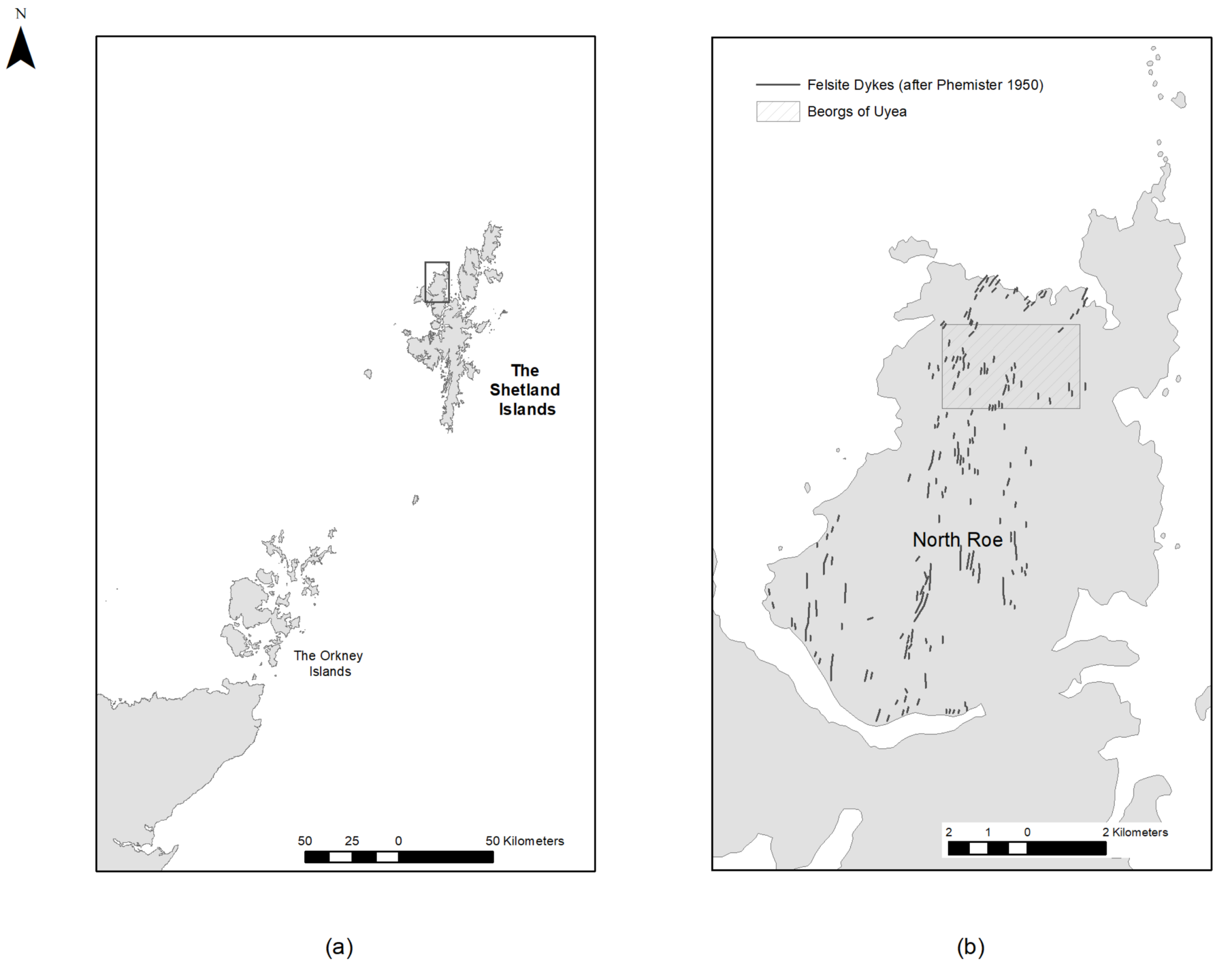
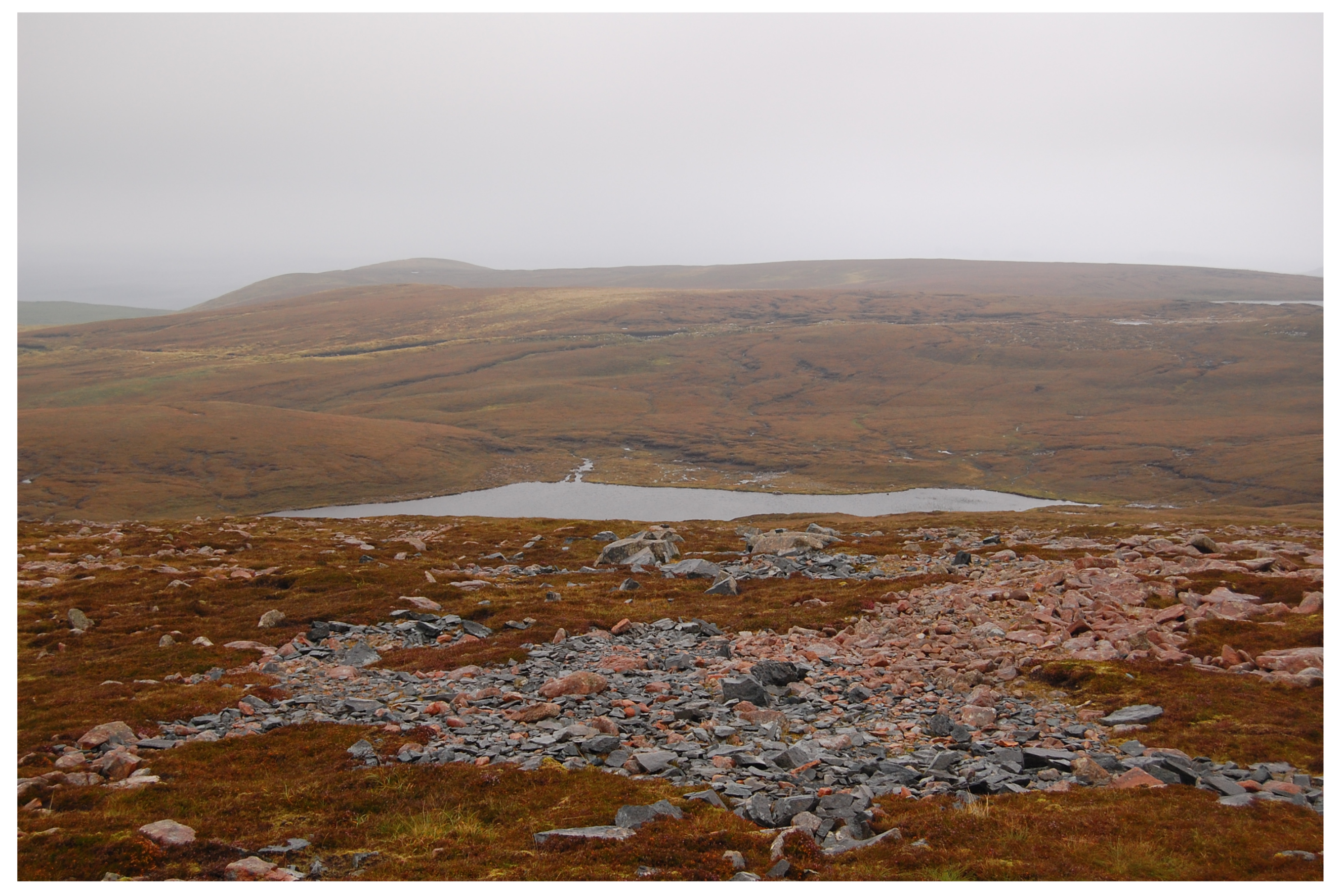
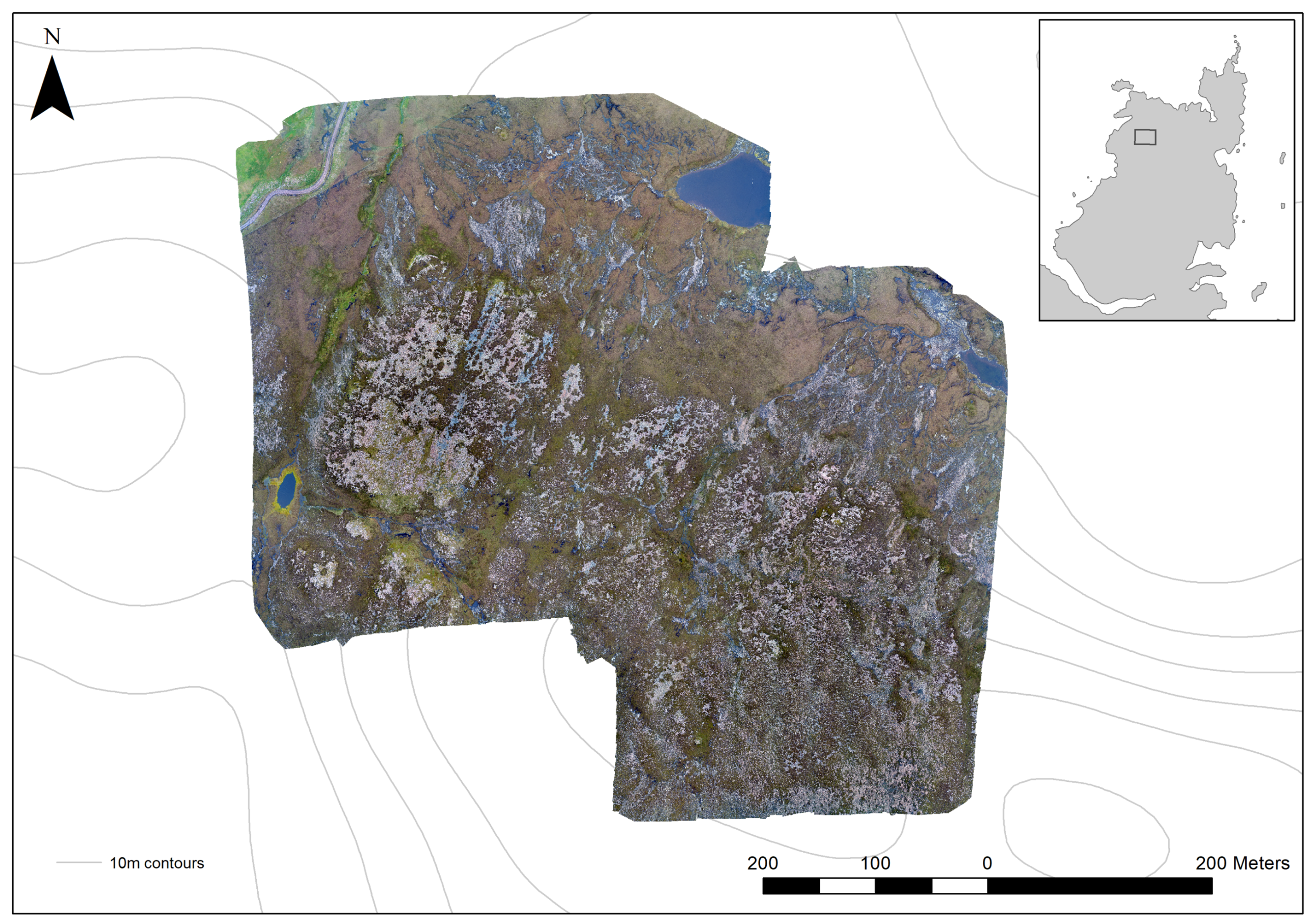
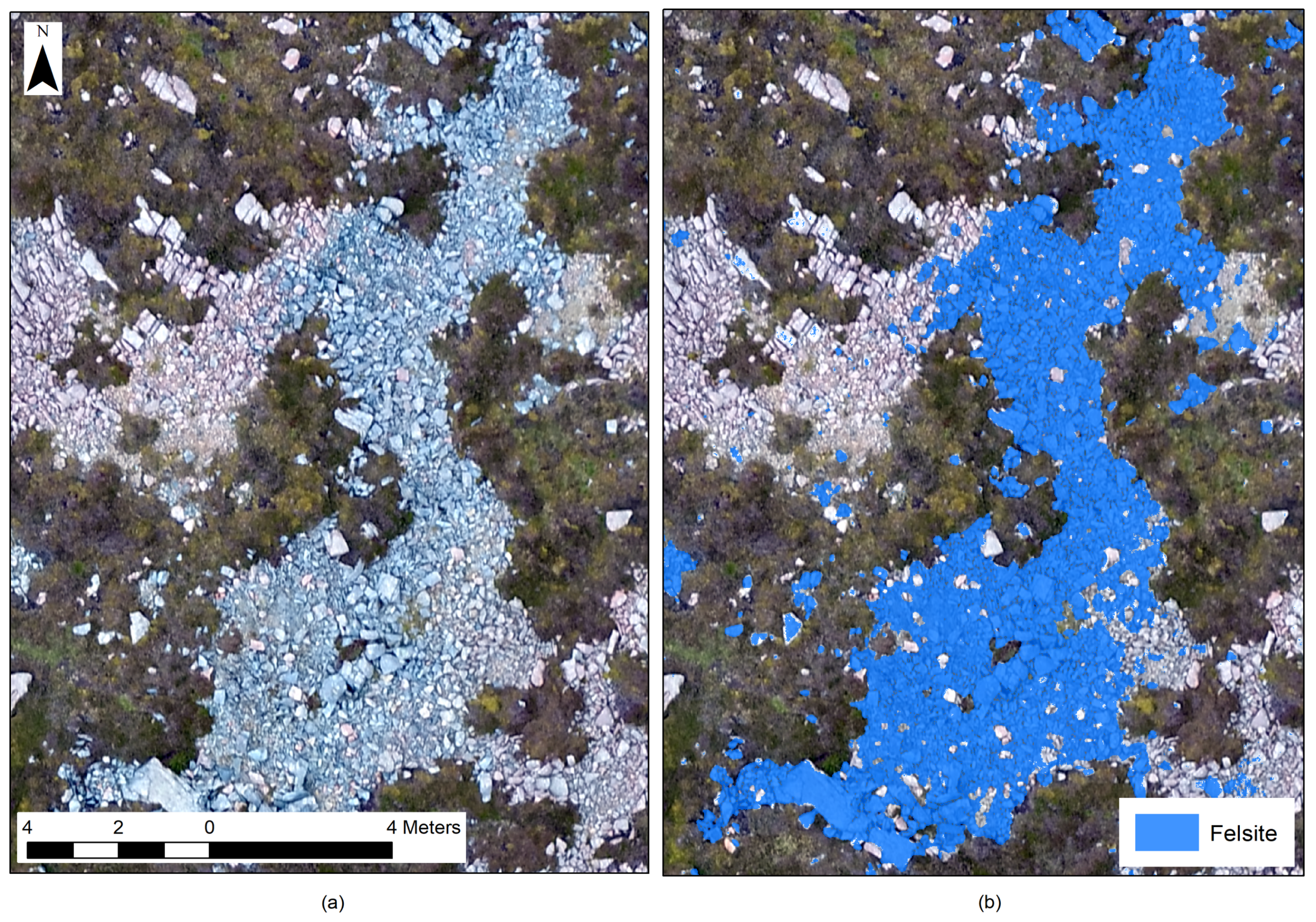
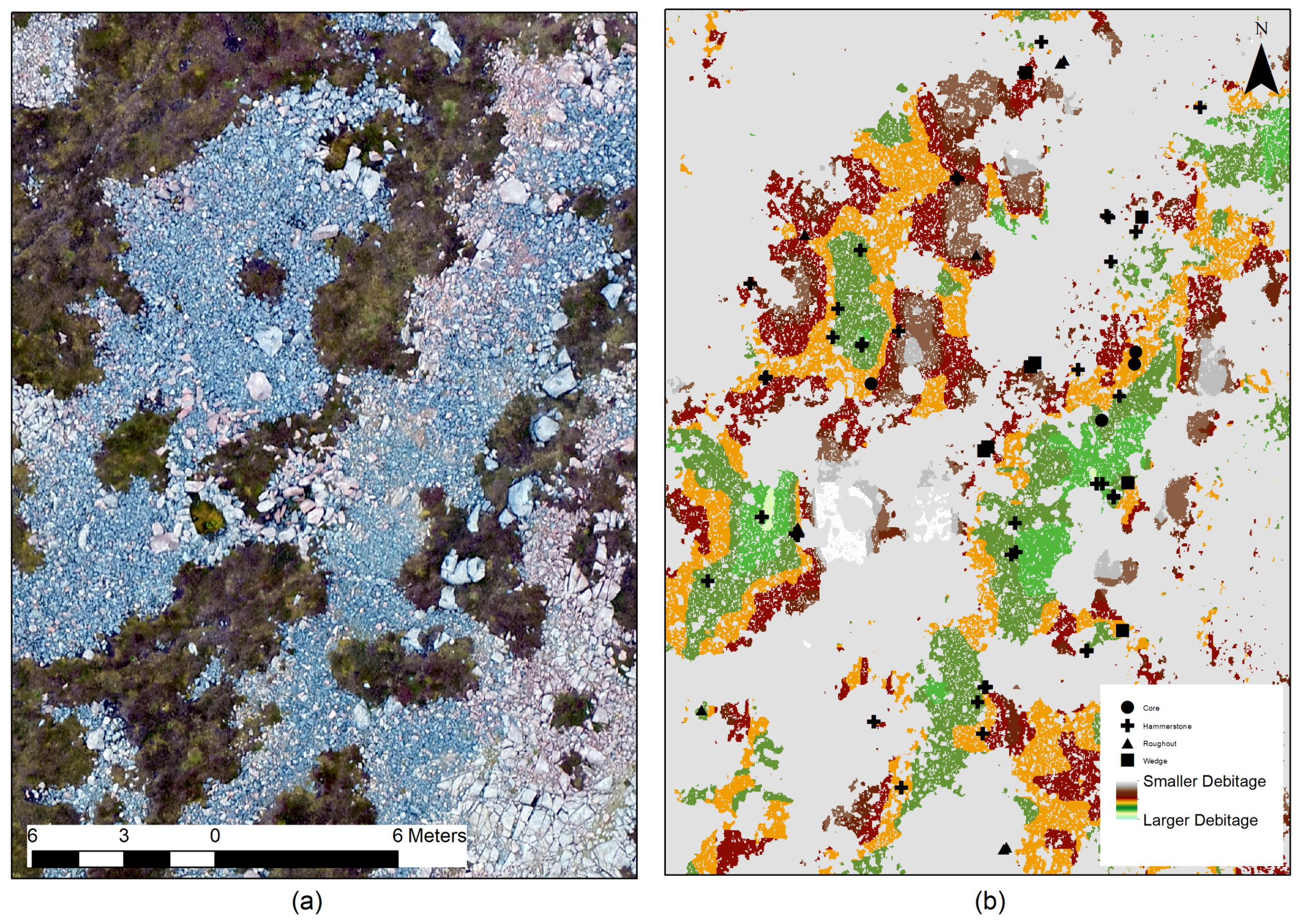

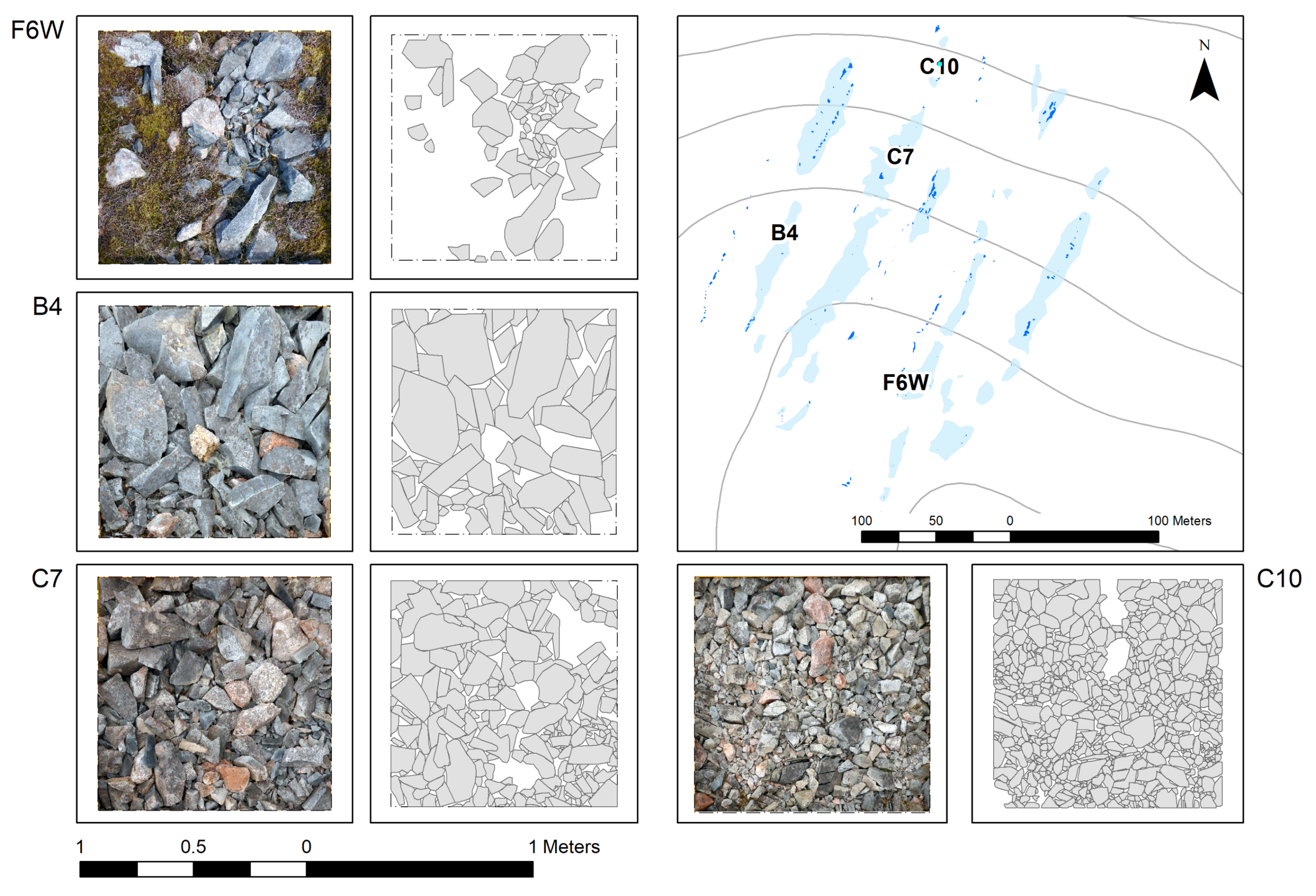

| Class | Felsite | Grass | Heather | Granite | Water | Producer’s Accuracy | Kappa Statistic |
|---|---|---|---|---|---|---|---|
| Felsite | 48 | 0 | 0 | 3 | 3 | 96% | 0.8611 |
| Grass | 0 | 50 | 0 | 0 | 0 | 100% | 1.0000 |
| Heather | 0 | 0 | 50 | 0 | 0 | 100% | 1.0000 |
| Granite | 1 | 0 | 0 | 47 | 0 | 94% | 0.9740 |
| Water | 1 | 0 | 0 | 0 | 47 | 94% | 0.9740 |
| Characterisation Square | % Coverage | Mean Size 1 | Rugosity Mean |
|---|---|---|---|
| F6W | 33 | 0.006369 | 0.0189951 |
| B4 | 77 | 0.011487 | 0.0211256 |
| C7 | 84 | 0.00384 | 0.0298886 |
| C10 | 89 | 0.001364 | 0.0279153 |
| Artefact Types | No. Artefacts 1 | Rugosity Mean | Range | Std |
|---|---|---|---|---|
| Roughouts | 29 | 0.031972 | 0.051509 | 0.010989 |
| Hammerstones | 58 | 0.028975 | 0.047248 | 0.008668 |
| Cores | 21 | 0.034256 | 0.085475 | 0.016943 |
| Wedges | 13 | 0.032123 | 0.024162 | 0.006815 |
© 2018 by the authors. Licensee MDPI, Basel, Switzerland. This article is an open access article distributed under the terms and conditions of the Creative Commons Attribution (CC BY) license (http://creativecommons.org/licenses/by/4.0/).
Share and Cite
Megarry, W.; Graham, C.; Gilhooly, B.; O’Neill, B.; Sands, R.; Nyland, A.; Cooney, G. Debitage and Drones: Classifying and Characterising Neolithic Stone Tool Production in the Shetland Islands Using High Resolution Unmanned Aerial Vehicle Imagery. Drones 2018, 2, 12. https://doi.org/10.3390/drones2020012
Megarry W, Graham C, Gilhooly B, O’Neill B, Sands R, Nyland A, Cooney G. Debitage and Drones: Classifying and Characterising Neolithic Stone Tool Production in the Shetland Islands Using High Resolution Unmanned Aerial Vehicle Imagery. Drones. 2018; 2(2):12. https://doi.org/10.3390/drones2020012
Chicago/Turabian StyleMegarry, William, Conor Graham, Bernard Gilhooly, Brendan O’Neill, Rob Sands, Astrid Nyland, and Gabriel Cooney. 2018. "Debitage and Drones: Classifying and Characterising Neolithic Stone Tool Production in the Shetland Islands Using High Resolution Unmanned Aerial Vehicle Imagery" Drones 2, no. 2: 12. https://doi.org/10.3390/drones2020012





